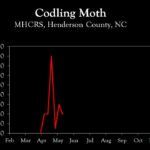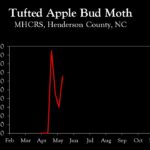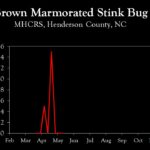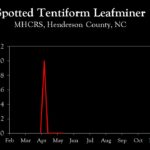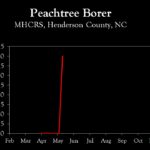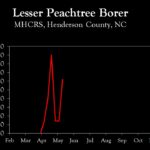WNC Orchard Insect Pest Populations – May 17, 2023
go.ncsu.edu/readext?936314
en Español / em Português
El inglés es el idioma de control de esta página. En la medida en que haya algún conflicto entre la traducción al inglés y la traducción, el inglés prevalece.
Al hacer clic en el enlace de traducción se activa un servicio de traducción gratuito para convertir la página al español. Al igual que con cualquier traducción por Internet, la conversión no es sensible al contexto y puede que no traduzca el texto en su significado original. NC State Extension no garantiza la exactitud del texto traducido. Por favor, tenga en cuenta que algunas aplicaciones y/o servicios pueden no funcionar como se espera cuando se traducen.
Português
Inglês é o idioma de controle desta página. Na medida que haja algum conflito entre o texto original em Inglês e a tradução, o Inglês prevalece.
Ao clicar no link de tradução, um serviço gratuito de tradução será ativado para converter a página para o Português. Como em qualquer tradução pela internet, a conversão não é sensivel ao contexto e pode não ocorrer a tradução para o significado orginal. O serviço de Extensão da Carolina do Norte (NC State Extension) não garante a exatidão do texto traduzido. Por favor, observe que algumas funções ou serviços podem não funcionar como esperado após a tradução.
English
English is the controlling language of this page. To the extent there is any conflict between the English text and the translation, English controls.
Clicking on the translation link activates a free translation service to convert the page to Spanish. As with any Internet translation, the conversion is not context-sensitive and may not translate the text to its original meaning. NC State Extension does not guarantee the accuracy of the translated text. Please note that some applications and/or services may not function as expected when translated.
Collapse ▲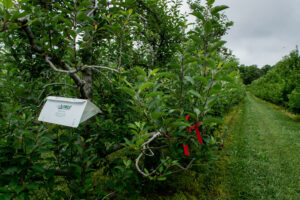 The codling moth remains the key pest at this time, and relatively warm temperatures during the past week have accelerated degree day (DD) accumulations throughout the region. DD accumulations in lower elevations (e.g., Cleveland, Burke Co.) are at about 550, which coincides with about 80% of first generation moths emerged, and 30% of eggs hatched. This is a time when populations are most intense, and insecticides should be a part of the management program at this time if mating disruption is not being used. In higher elevations (Henderson County), we have reached about 370 DD, which represents 55% adult emergence and 5% egg hatch. Generally, the need for first generation management runs from about 250 to 1000 DDs, with the period between about 350 to 800 most critical.
The codling moth remains the key pest at this time, and relatively warm temperatures during the past week have accelerated degree day (DD) accumulations throughout the region. DD accumulations in lower elevations (e.g., Cleveland, Burke Co.) are at about 550, which coincides with about 80% of first generation moths emerged, and 30% of eggs hatched. This is a time when populations are most intense, and insecticides should be a part of the management program at this time if mating disruption is not being used. In higher elevations (Henderson County), we have reached about 370 DD, which represents 55% adult emergence and 5% egg hatch. Generally, the need for first generation management runs from about 250 to 1000 DDs, with the period between about 350 to 800 most critical.
Learn more about southeastern apple insect pests at the Apple Insect Management page.
2023 Average Weekly Trap Captures
| HENDERSON COUNTY | |||
| Insects per trap | |||
| May 1 | May 8 | May 15 | |
| Codling moth | 0.5 | 3.0 | 2.0 |
| Oriental fruit moth | 26.0 | 38.0 | 29.0 |
| Tufted apple bud moth | 9.0 | 6.0 | 13.0 |
| Redbanded leafroller | 0.0 | 0.0 | 0.0 |
| Obliquebanded leafroller | – | – | 3.0 |
| Lesser appleworm | – | – | – |
| Apple maggot (abandoned and research orchards) | – | – | – |
| Brown marmorated stink bug (commercial) | – | – | – |
| Brown marmorated stink bug (unsprayed) | 0.0 | 0.0 | 0.0 |
| Spotted tentiform leafminer | 0.0 | 0.0 | 0.0 |
| Dogwood borer | 1.0 | 4.0 | 27.0 |
| Peachtree borer | 0.0 | 0.0 | 4.0 |
| Lesser peachtree borer | 7.0 | 7.0 | 31.0 |
| San Jose scale | 0.0 | 0.0 | 0.0 |
*Note that these averages illustrate only the timing of insect emergence and fluctuations in populations, and are not representative of population levels in any given orchard. The only way to have an accurate assessment of an individual orchard’s populations is to set up traps in that orchard.
2023 Accumulated Degree Days
| HENDERSON COUNTY | ||||
| May 1 | May 8 | May 15 | ||
| Codling moth (Biofix: April 7) | 170 | 220 | 338 | |
| Oriental fruit moth (Biofix: March 24) | 433 | 508 | 662 | |
| Tufted apple bud moth (Biofix: April 21) | 80 | 155 | 308 | |



